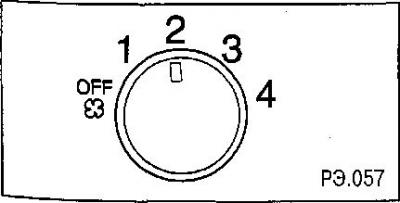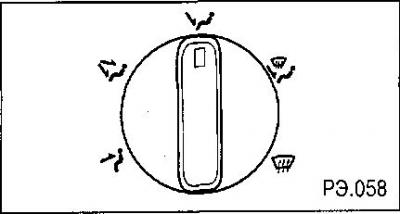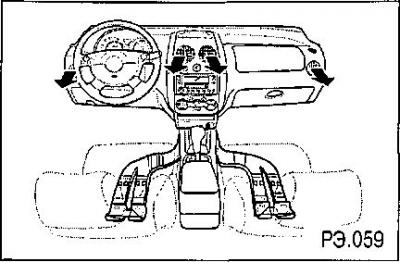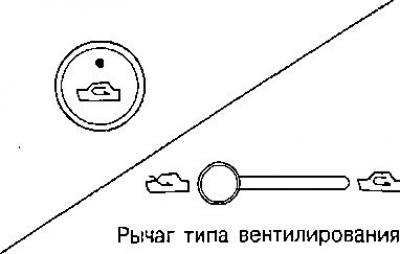The amount of air supplied to the passenger compartment is determined by the fan speed. Therefore, for efficient operation of the heating and ventilation system, the fan must be turned on even when the vehicle is moving.
Central ventilation grilles
Air can enter the passenger compartment through both central ventilation grilles. The direction of air flow from the central grilles can be adjusted at the request of the driver and passengers, both in horizontal and vertical planes using levers that tilt the grilles and rotate the deflectors.

The location of the ventilation grilles on the instrument panel: 1 - side ventilation grilles; 2 - ventilation grilles of the windshield heater; 3 - central ventilation grilles; 4 - floor ventilation grilles; 5 - front door window grilles.
Side ventilation grilles
Air can also enter the passenger compartment through the left and right side ventilation grilles.
Grilles for blowing the windshield and front door windows
Cold or warm air can be blown to both the windshield and side windows of the front doors (mainly in areas that provide the driver with a view through the outside rear-view mirrors).
Floor ventilation grilles
They direct the air towards the leg area of the passengers in the front seat.
Airflow for the passenger footwell in the rear seat (option)
Cold or warm air enters this area through the vents located under the front seats.

Climate control panel: 1 - air temperature controller; 2 - fan operation mode switch; 3- air distribution regulator; 4 - air conditioner switch (A/C) (option), 5 - air recirculation mode regulator; 6 - switch for the electric heater of the rear window and rear-view mirror.
Air temperature controller
The regulator provides a smooth change over a wide range of air temperature entering the vehicle interior through the ventilation grilles. In this case, the outside air can be heated, cooled or directed into the passenger compartment without changing the temperature.

- blue zone (A): cold air
- red zone (B): warm air
Fan mode switch

The switch is designed to control the fan speed. In total, there are four operating positions of the switch, which correspond to four steps of the fan speed. The amount of air entering the passenger compartment can be increased by switching the fan to a higher speed. To ensure comfortable conditions in the cabin, the fan must be turned on while the car is moving.
Air distribution controller
The regulator allows you to set the desired mode of distribution of air entering the passenger compartment. The air distribution control knob can be in any of five positions, indicated by the corresponding symbols:

- ventilation of the upper zone;
- two-level ventilation;
- ventilation of the lower zone;
- lower zone ventilation and glass blowing;
- glass blowing.
Direction of air flow depending on the position of the regulator
Position

Position
Air enters the passenger compartment simultaneously through the central and side ventilation grilles, and is also directed through the lower ventilation openings to the front passenger and driver's footwell.

Position (lower zone ventilation)
Air mainly enters through the lower vents to the front passenger and driver footwells. A small amount of air goes to the windshield and side windows.

Position
Air enters through the lower vents into the front passenger and driver footwells. At the same time, air is directed through the upper ventilation nozzles and grilles to blow the windshield and side windows of the front doors.

Position
The air is directed to the windshield defroster nozzles and the front door side window vents.

Air recirculation control
The ventilation, heating and air conditioning system can operate in two modes: normal (with the intake of fresh, outside air into the cabin) and in recirculation mode - when air access to the passenger compartment from the outside stops. Modes are switched using the regulator of air intake into the passenger compartment.
Your vehicle may have a mode switch, either push-button or lever type.

Regulator options (switch) air recirculation mode
When the button is pressed, the control lamp will light up and air will begin to circulate in a closed circuit without exchange with the atmosphere. When the button is pressed again, the recirculation mode will turn off, the indicator will turn off and the flow of outside air into the car interior will begin.
If the switch is made in the form of a lever regulator, to select the mode of intake of outside air into the passenger compartment, move the regulator lever to the left, and to turn on the recirculation mode (with interruption of outdoor air supply) - to the right,
Use the recirculation mode when driving in very dusty areas or in heavy traffic to avoid dust and polluted air from entering the vehicle interior. This mode can also be useful for quickly lowering or raising the cabin air temperature.
Attention: turn on this mode for a short time, as it becomes stuffy in the cabin, and an increase in air humidity leads to fogging of the windows, which, in turn, impairs visibility.
